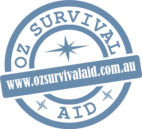Heat related medical situations are serious life threatening conditions in Australia, being the driest inhabitable continent on Earth. People do regularly die from dehydration. As always prevention is far better than the cure so please plan ahead and take a few basic precautions.
First aid kits to be used when travelling in dry warm destinations should always include electrolyte rehydration tables or satchels. These are readily available at grocery stores and chemists. Always protect yourself and family from the sun by wearing appropriate clothing and a brim hat is a must no matter how ‘daggie’ one looks. Sun exposure and particularly sunburn will exacerbate dehydration. If driving in remote locations plan for a vehicle breakdown and pack plenty of back-up water.
Never push yourself or others in warm conditions, particularly when hiking long distances. It is very easy for some to believe that they can ‘push-on’. So many people totally underestimate Australian conditions, especially international tourists who are unaware and unconditioned to our harsh environments. When it’s warm, take regular rests in the shade and relax, enjoy the scenery, and frequently and consistently consume fluids. It is also important to eat healthy foods when it’s hot to help maintain body electrolytes, as drinking a lot of water can dilute necessary salts.
If one does become affected by heat related conditions then immediately recognise this as a potentially serious ailment and take direct action. Heat induced conditions are divided into two main categories: heat exhaustion and Heatstroke. Heat exhaustion can be rectified, being the lessor emergency, if recognised and acted upon straight away. Heat exhaustion can turn into heatstroke where urgent medical response must be sought. Become familiar with these symptoms and required treatments, and take a copy for your next outing. PDF copies are emailed to all members on our website – www.ozcampinggear.com.au.
Heat Exhaustion Symptoms are:
- Feeling hot, exhausted, fatigued and weak
- Persistent headache
- Thirst and nausea
- Giddiness fainting feeling
- Difficult and rapid breathing
- Clammy, pale and cool skin
- Weak rapid pulse
Heat Exhaustion Treatment:
- Enable the patient to lie down in a cool place with circulating air.
- Remove any unnecessary clothing and loosen any tight clothing and shoes.
- Sponge the patient with cool water and place a wet cool towel around the neck.
- Allow the patient to drink water and if possible an electrolyte hydration solution.
- If the patient vomits or does not recover quickly seek medical attention.
- Ensure that the patient drinks plenty of fluids after the event.
Heatstroke symptoms are:
- High body temperature reaching 40 degrees C and higher
- Flushed and dry skin
- Rapid pounding pulse
- Headache, nausea and/or vomiting
- Dizziness and visual problems
- Irritability and confusion
- Seizures and unconsciousness
Heatstroke Treatment:
1. Follow DRSABCD – Danger
– Response
– Send for help
– Airway
– Breathing
– CPR
– Defibrillation
2. Ask for bystander assistance if possible; call Triple Zero – 000
3. Place the patient in shade or an air-conditioned room if possible.
4. Remove any unnecessary clothing and loosen any tight fitting clothing and shoes.
5. Apply cold packs, ice wrapped in cloth etc to the patients neck, groin and armpits.
6. Cover the patient with a wet sheet, towel etc.
7. Encourage the patient if conscious and able to swallow to drink water.
8. Seek urgent medical attention if the patient is unconscious or having seizures.
* We highly recommend undertaking a first-aid course or renewing one as there can be nothing more valuable than having the skills and knowledge to save someone’s life.

